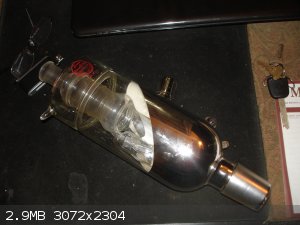SWIM
National Hazard
   
Posts: 970
Registered: 3-9-2017
Member Is Offline
|
|
Distillation problems using different diameter glassware.
Is there much of a problem with using equipment with varying diameters in a distillation rig?
What I mean is can you use a larger diameter fractionating column with adaptors without running into some sort of problems from the change in vapor
velocity from the column to the head?
I'm talking about using a 45/50 column with adaptors along with a 29/42, or even 24/40 size heads and condensers.
I'm thinking the wider column might even be a slight improvement because of the slower vapor transit through the column, but would appreciate hearing
any thoughts or experiences on this sort of thing.
|
|
|
Sulaiman
International Hazard
    
Posts: 3558
Registered: 8-2-2015
Location: 3rd rock from the sun
Member Is Offline
|
|
over-sized columns allow greater throughput at the cost of greater holdup,
- for a Vigreux column that should be negligible.
It is possible that heat cannot be put into a small rbf holding the boiling liquid
as quickly as an oversized column can remove it
- unless insulated to some degree
Given the choice I'd rather run an (easily insulated) oversized column than an (easily flooded) undersized column.
You can run your heating for rapid boiling
and adjust/reduce the insulation of the column to increase the internal reflux ratio
(giving better fractionation)
so that the smaller condenser is not overwhelmed.
(or more practically, increase the column insulation until the vapour front reaches the condenser and a reasonable product collection rate is
achieved).
[Edited on 1-4-2019 by Sulaiman]
CAUTION : Hobby Chemist, not Professional or even Amateur
|
|
|
SWIM
National Hazard
   
Posts: 970
Registered: 3-9-2017
Member Is Offline
|
|
Thanks Sulaiman.
Good to get the opinion of an engineer who has an interest in these matters as well.
It's actually a 600 mm column, but with a vacuum jacket and silvering, so the heat lose is probably pretty low.
|
|
|
markx
National Hazard
   
Posts: 645
Registered: 7-8-2003
Location: Northern kingdom
Member Is Offline
Mood: Very Jolly
|
|
If you wish to run the system at a capacity that is allowed by the size of the column, then the smaller "bottlenecks" in the vapour path are likely to
create a bubblecap effect. The liquid phase can not return through the restricting connectors due to vapour speed and pressure from below and starts
to collect above them causing flooding problems. Also it may create sharp jumps in the pressure gradient through the column. If none of these effects
shall cause harm to your purpose, then it probably shall work just fine.
Exact science is a figment of imagination.......
|
|
|
Sulaiman
International Hazard
    
Posts: 3558
Registered: 8-2-2015
Location: 3rd rock from the sun
Member Is Offline
|
|
Quote: Originally posted by SWIM  | | ...It's actually a 600 mm column, but with a vacuum jacket and silvering, so the heat lose is probably pretty low. |
I have no experience with silvered vacuum jacketed columns,
but if the silvering and vacuum do a good job as I believe they should,
there will be very little heat loss from your column,
so there will be very little internal refluxing.
This implies to me that you need to either go EXTREMELY slowly to have good fractionation,
or, add a reflux condenser and partial take off head above the column.
Other than that I guess that you will need a less efficient column 
Regarding the vapour flow mentioned by markx above,
to me this translates as 'don't put packing in narrower sections'
CAUTION : Hobby Chemist, not Professional or even Amateur
|
|
|
BromicAcid
International Hazard
    
Posts: 3227
Registered: 13-7-2003
Location: Wisconsin
Member Is Offline
Mood: Rock n' Roll
|
|
Round and round we go. You want the column completely adiabatic if possible. Vacuum jacketed silvered columns help loads. Ideologically I agree
with Sulaiman that you want heat loss so that you have refluxing in your column to give theoretical plates. Unfortunately that is completely false.
Better minds than myself have looked into this. If you want to dig into it you can start with the SM threads then work into the literature.
http://www.sciencemadness.org/talk/viewthread.php?tid=38826
http://www.sciencemadness.org/talk/viewthread.php?tid=12409
|
|
|
Magpie
lab constructor
    
Posts: 5939
Registered: 1-11-2003
Location: USA
Member Is Offline
Mood: Chemistry: the subtle science.
|
|
Adiabatic is good. Note that refinery distillation columns are insulated. What you want is condensing of low vapor pressure components and
evaporation of high vapor pressure components. That is the job of the column. This is not refluxing.
Narrow columns are prone to flooding but have less holdup. Longer columns give better separation but you need more heat to drive the components up
the column.
I usually work with small volumes so excessive holdup can be a problem for me.
[Edited on 5-4-2019 by Magpie]
[Edited on 6-4-2019 by Magpie]
The single most important condition for a successful synthesis is good mixing - Nicodem
|
|
|
S.C. Wack
bibliomaster
    
Posts: 2419
Registered: 7-5-2004
Location: Cornworld, Central USA
Member Is Offline
Mood: Enhanced
|
|
It would be simple enough to experimentally test separation ability with whichever smaller and larger size (except for the column) and the same amount
of the same mixture at the same rate. It would not be surprising if the results varied by operator, mixture, and hardware.
It would also not be a surprise if columns are typically designed for a vertical rather than horizontal thermal gradient...what works for a Vigreux is
not what works for a packed column.
[Edited on 7-4-2019 by S.C. Wack]
|
|
|
markx
National Hazard
   
Posts: 645
Registered: 7-8-2003
Location: Northern kingdom
Member Is Offline
Mood: Very Jolly
|
|
Quote: Originally posted by Sulaiman  |
Regarding the vapour flow mentioned by markx above,
to me this translates as 'don't put packing in narrower sections' |
One does not have to put packing there (it sure does not help with improving "floodproofness") and can still have problems if the dimensions are a big
enough mismatch. But really, every setup is different and behaves in a different manner. Even between separate runs one can observe remarkable
fluctuations on the same setup regarding efficacy, flooding and output.
The discussion about what is the best configuration can be stretched for miles and years, but in the end one just has to put together a system and
learn how to operate it in a way that is most suitable for this apparatus and the end purpose.
Exact science is a figment of imagination.......
|
|
|
SWIM
National Hazard
   
Posts: 970
Registered: 3-9-2017
Member Is Offline
|
|
Okay, adiabatic with partial take off.
Reckon I'll use one of these magnetic gizmos.
The other picture is with it on the column. I added a coonskin cap to the picture for scale.
That way you can use your own coonskin cap to estimate the size.
 
The head's got an 24/40 adaptor stuck in the top that's probably never coming out because the vacuum jacket makes it tough to use a torch, and it
can't be pushed or tapped from the bottom because that thing has obstructions inside it (glass tubing, fragile glass tubing), but that puts the
restriction between the head and condenser which may be less of a problem than having a restriction right above the column.
It'll be the second shiniest still around this lab.
|
|
|
markx
National Hazard
   
Posts: 645
Registered: 7-8-2003
Location: Northern kingdom
Member Is Offline
Mood: Very Jolly
|
|
Impressive glassware!  Be sure to treat it carefully, would be a shame if one
breaks a beauty like that one. Be sure to treat it carefully, would be a shame if one
breaks a beauty like that one.
I would leave any stuck adaptors or other joints well alone as they are and work around them by adjusting other parameters to make the system work
properly.
Exact science is a figment of imagination.......
|
|
|